-
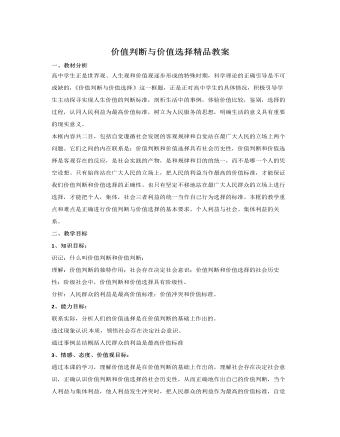
人教版高中政治必修4价值判断与价值选择精品教案
南极大地的水陆交接处,全是滑溜溜的冰层或者尖锐的冰棱。企鹅没有可以用来攀爬的前臂,也没有可以飞翔的翅膀,如何从水中上岸?纪录片《深蓝》展示,企鹅在将要上岸之时,要从海面潜入海中,沉潜到适当的深度,借用水的浮力,迅猛向上,飞出一道弧线,落于陆地之上。企鹅的沉潜是为了蓄势,看似笨拙,却富有成效。人生又何尝不是如此?沉潜绝非沉沦,而是勇敢、智慧、自强。如果我们在困难面前能沉下气来,不被“冰棱”吓倒,不被浮华迷惑,专心致志,自强不息,积聚力量,并抓住恰当的机会反弹向上,毫无疑问,我们就能成功登陆!反之,总是随波浮沉,或者怨天尤人,注定就会被命运的风浪所玩弄,直至精疲力竭。结合上述材料,运用《生活与哲学》知识对“价值观是人生的重要向导,有价值观的人生才是更美的人生”加以评析。7、有两名畜牧兽医专业毕业的大学生应聘到农村养猪场担任技术总监后,大力推广使用生态养猪法和中草药防疫技术,使养猪场步入了良性发展轨道。
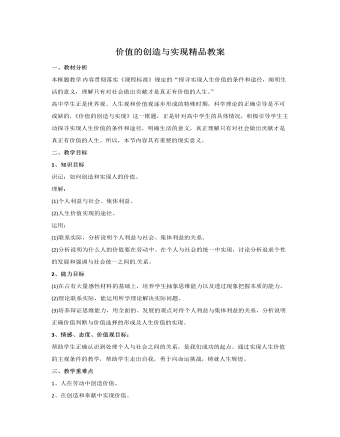
人教版高中政治必修4价值的创造与实现精品教案
2、能力目标(1)在占有大量感性材料的基础上,培养学生抽象思维能力以及透过现象把握本质的能力。(2)理论联系实际,能运用所学理论解决实际问题。(3)培养辩证思维能力,用全面的、发展的观点对待个人利益与集体利益的关系,分析说明正确价值判断与价值选择的形成及人生价值的实现。3、情感、态度、价值观目标:帮助学生正确认识到处理个人与社会之间的关系,是我们成功的起点。通过实现人生价值的主观条件的教学,帮助学生走出自我,勇于向命运挑战,铸就人生辉煌。三、教学重难点1、人在劳动中创造价值。2、在创造和奉献中实现价值。3、理解自我价值与社会价值的统一。四、学情分析高中二年级学生已经学习了哲学常识的大多数内容,基本掌握了唯物论、辩证法的科学认识问题、分析问题的方法,基本树立了正确的理想信念和价值观,了解了古今中外大量典型人物的事例,所以,应该能够比较容易地理解课本知识。
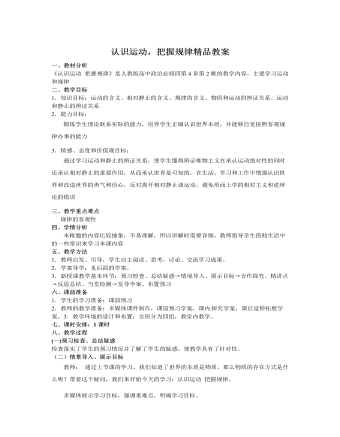
人教版高中政治必修4认识运动,把握规律精品教案
一、教材分析 《认识运动 把握规律》是人教版高中政治必修四第4章第2框的教学内容,主要学习运动和规律二、教学目标1.知识目标:运动的含义、相对静止的含义、规律的含义、物质和运动的辨证关系、运动和静止的辨证关系2.能力目标: 锻炼学生理论联系实际的能力,培养学生正确认识世界本质,并能够自觉按照客观规律办事的能力3.情感、态度和价值观目标:通过学习运动和静止的辨证关系,使学生懂得辨证唯物主义在承认运动绝对性的同时还承认相对静止的重要作用,从而承认世界是可知的,在生活、学习和工作中增强认识世界和改造世界的勇气和信心,反对离开相对静止谈运动,避免形而上学的相对主义和诡辩论的错误三、教学重点难点规律的客观性四、学情分析本框题的内容比较抽象,不易理解,所以讲解时需要详细。教师指导学生借助生活中的一些常识来学习本课内容
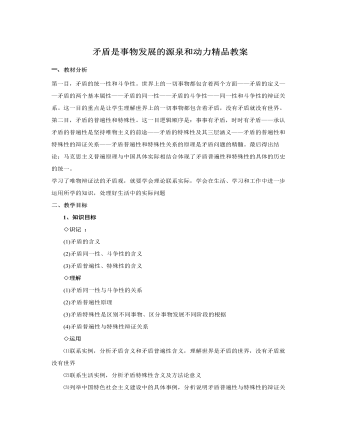
人教版高中政治必修4矛盾是事物发展的源泉和动力精品教案
一、教材分析第一目,矛盾的统一性和斗争性。世界上的一切事物都包含着两个方面——矛盾的定义——矛盾的两个基本属性——矛盾的同一性——矛盾的斗争性——同一性和斗争性的辩证关系。这一目的重点是让学生理解世界上的一切事物都包含着矛盾,没有矛盾就没有世界。第二目,矛盾的普遍性和特殊性。这一目逻辑顺序是:事事有矛盾,时时有矛盾——承认矛盾的普遍性是坚持唯物主义的前途——矛盾的特殊性及其三层涵义——矛盾的普遍性和特殊性的辩证关系——矛盾普遍性和特殊性关系的原理是矛盾问题的精髓。最后得出结论:马克思主义普遍原理与中国具体实际相结合体现了矛盾普遍性和特殊性的具体的历史的统一。学习了唯物辩证法的矛盾观,就要学会理论联系实际,学会在生活、学习和工作中进一步运用所学的知识,处理好生活中的实际问题
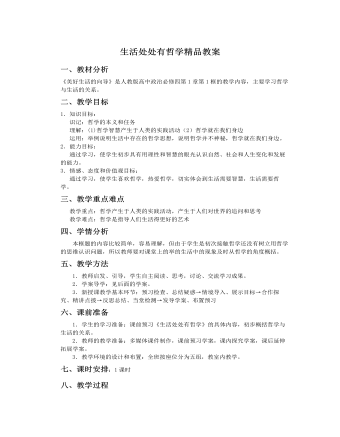
人教版高中政治必修4生活处处有哲学精品教案
(三)合作探究、精讲点拨。探究一:探究问题:如何看待排名一名高中生在谈到“排名的二重性”时说:“我们既不能盲目地张扬排名,也不能简单地否定排名。作为学生,如果用片面的观点对待排名,排在前面沾沾自喜、骄傲自满,排在后面灰心丧气、一蹶不振,就会停滞不前,甚至倒退;如果通过排名了解自己的学习实力以及同别人的差距,做到知彼知己,扬长避短,就会出现先进更先进、后进赶先进的生动局面。”问题:(1)在排名问题上,人们的看法往往各不相同,这是为什么?(2)为什么我们应看到排名的“二重性”?(3)联系生活中类似的事例,谈谈生活与哲学的关系。教师活动:指导学生阅读以上的材料,并思考所提问题。学生活动:阅读材料,分组讨论问题,发表自己的观点,分析材料中包含的哲学道理。教师点评:(1)在排名问题上,人们的看法不同,主要是因为人们的思维方法不同。
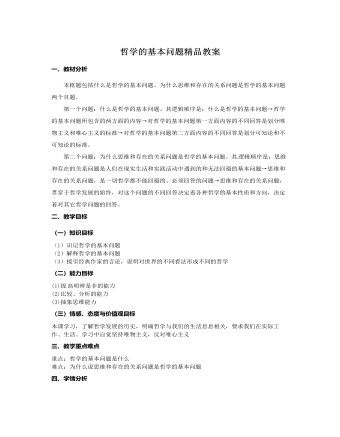
人教版高中政治必修4哲学的基本问题精品教案
一、教材分析本框题包括什么是哲学的基本问题、为什么思维和存在的关系问题是哲学的基本问题两个目题。第一个问题:什么是哲学的基本问题。其逻辑顺序是:什么是哲学的基本问题→哲学的基本问题所包含的两方面的内容→对哲学的基本问题第一方面内容的不同回答是划分唯物主义和唯心主义的标准→对哲学的基本问题第二方面内容的不同回答是划分可知论和不可知论的标准。第二个问题:为什么思维和存在的关系问题是哲学的基本问题。其 逻辑顺序是:思维和存在的关系问题是人们在现实生活和实践活动中遇到的和无法回避的基本问题→思维和存在的关系问题,是一切哲学都不能回避的、必须回答的问题→思维和存在的关系问题,贯穿于哲学发展的始终,对这个问题的不同回答决定着各种哲学的基本性质和方向,决定着对其它哲学问题的回答。 二、教学目标(一)知识目标(1)识记哲学的基本问题(2)解释哲学的基本问题

新人教版高中英语必修3Unit 1 Festivals and Celebrations-Listening &Speaking&Talking教学设计
The theme of this section is “Talk about festival activities and festival experiences”.Festival and holiday is a relaxing and interesting topic for students. This part talks about the topic from the daily life of students’. In the part A ---Listening and Speaking, there are three conversations among different speakers from three countries(Japan, Rio and China), where the speakers are participating in or going to participate in the festivals and celebrations. So listening for the relationship among them is a fundamental task. Actually, with the globalization and more international communication, it is normal for Chinese or foreigners to witness different festivals and celebrations in or out of China. In the Conversation 1, a foreign reporter is interviewing a Japanese young girl who just had participated in the ceremony of the Coming-of-Age Day on the street and asking her feeling about the ceremony and the afterwards activities. Conversation 2, Chinese girl Li Mei is witnessing the Rio Carnival for the first time, and her friend Carla gives her some advice on the costumes which enables her to match with the carnival to have a good time. Conversation 3, a Chinese guide is showing a group of foreign visitors around the Lantern Festival and introducing the customs of the festival to them. The three conversations have a strong vitality and insert the festival and cultural elements from different countries. So perceiving the festivals and cultures from different countries is the second task. At the same time, the scripts also insert the targeted grammar --- v-ing as attributive and predicative, which students can perceive and experience in a real context and make a road for the further study. That is the third task. In the Part B--- Listening and Talking, the theme is “Talk about festival experience”, which is the common topic in our daily conversations. During the conversation, Song Lin, a Chinese student, asked Canadian friend Max about how to spend Christmas. In the conversation, Song Lin talked about experience and the feelings during the Chinese Spring Festival, during which there are not only some enjoyable things but some unpleasant things. After the listening, perhaps students find there are some similarities between Christmas and the Chinese Spring Festival as there are some differences in the origins and celebrations. For example, people always visit friends and relatives, decorate their houses, have a big dinner together, chat and give presents to each other.

新人教版高中英语必修3Unit 3 Diverse Cultures-Discovering Useful Structure教学设计
Step 4 PracticeRead the conversation. Find out which words have been left out.Justin: Linlin, I’m going to Guizhou Province next month. I’m super excited! Any recommendations for places to visit?Linlin: Wow, cool! Guizhou is a province with a lot of cultural diversity. Places to visit...well, definitely the Huangguoshu Waterfall first.Justin: What’s special about the waterfall?Linlin: Well, have you ever heard of the Chinese novel Journey to the West ?Justin: Yes, I have. Why ?Linlin: In the back of the waterfall, you will find a cave, which is the home of the Monkey King.Justin: Really? Cool! I’ll definitely check it out.Linlin:And I strongly recommend the ethnic minority villages. You’ll find Chinese culture is much more diverse than you thought.Justin:Sounds great, thanks.Answers:Justin: Linlin, I’m going to Guizhou Province next month. I’m super excited! Do you have any recommendations for places to visit?Linlin: Wow, that’s cool! Guizhou is a province with a lot of cultural diversity. What are some places to visit in Guizhou ? Well, definitely the Huangguoshu Waterfall is the first place to visit in Guizhou Province.Justin: What’s special about the waterfall?Linlin: Well, have you ever heard of the Chinese novel Journey to the West ?Justin: Yes, I have heard of the Chinese novel Journey to the West . Why do you ask if I have heard of the Chinese novel Journey to the West?Linlin: In the back of the waterfall, you will find a cave, which is the home of the Monkey King from Journey to the West.Justin: That’s really true? It’s Cool! I’ll definitely check it out.Linlin:And I strongly recommend the ethnic minority villages on your trip to Guizhou Province. You’ll find Chinese culture is much more diverse than you thought it was.Justin:This all sounds great, thanks.

新人教版高中英语必修3Unit 3 Diverse Cultures-Listening &Speaking&Talking教学设计
1. In Picture 1 and Picture 2, where do you think they are from? How do you know?From their wearings, we can know they are from ethnic minority of China--- Miao and Dong.Picture 1, they are playing their traditional instrument lusheng in their traditional costumes.Picture 2. the girls are Miao because they wear their traditional costumes and silver accessory.2. In Picture 3, can you find which village it is? What time is it in the picture?It is Dong village. It is at night. Step 2 While-listeningJustin met a new friend while traveling in Guizhou. Listen to their conversation and complete the summaries below.Part 1Justin and Wu Yue watched some Miao people play the lusheng. The instrument has a history of over 3,000 years and it is even mentioned in the oldest collection of Chinese poetry. Then they watched the lusheng dance. Justin wanted to buy some hand-made silver/traditional accessories as souvenirs. He was told that the price will depend on the percentage of silver. Part 2They will go to a pretty Dong minority village called Zhaoxing. they will see the drum towers and the wind and rain bridges. They may also see a performance of the Grand Song of the Dong people.Step 3 Post-listening---TalkingWork in groups. Imagine Justin is telling some friends about his trip to Guizhou. One of you is Justin and the rest of you are his friends. Ask Justin questions about his trip and experience. The following expressions may help you.
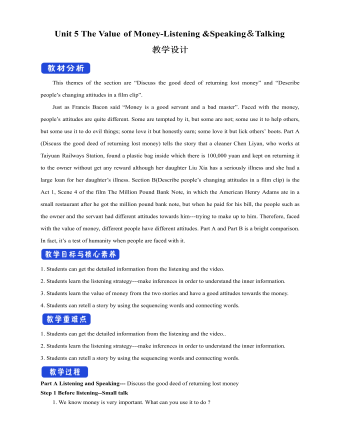
新人教版高中英语必修3Unit 5 The Value of Money-Listening &Speaking&Talking教学设计
4. A:We’d like to have someone to say a word at the beginning to welcome the group.B:↙Who?A:We thought that you or Dr.Johnson might do it.B用降调说Who,其意思是问,对方想让谁在开场时致欢迎词。Step 6 Pronunciation---Practice1. Listen to the short conversation and mark the intonation with ↗, ↙ or ↙, ↗. Then discuss with a partner what they intend to convey by using different intonation.Owner: You know what ?↗ It’s a million-pound bank note↙.Waiter 1: Really ?↗(question)Waiter 2: Really !↙(unbelievable and surprised)Waiter 3: Really ?!↙↗(first question then surprised)2. Listen to the conversations. Underline the parts that are stressed and mark the intonation. Then talk about the implied meanings of the responses with different intonations. Listen again and repeat.1) Henry: It’s a nice suit.Owner: Oh, it’s perfect!↙(The intonation means it is very suitable for Henry.)2) Henry: Well, that’s very kind of you.Owner: Kind, sir ?↗(what you said is not right) No, it’s kind of you. You must come whenever you want and have whatever you like. Just having you sit here is a great honour !!↙(welcome you to come again)3)Henry:Well, to be honest, I have none. Oliver:(happily) What luck!(excited) Brother↗, what luck!↙(It means “Didn’t you hear it?”)Henry: Well, it may seem lucky to you but not to me!↗(angry) If this is your idea of some kind of joke, I don’t think it’s very funny. Now if you’ll excuse me, I ought to be on my way.↙(If so, I would leave.)Roderick: Please don’t go↙...(hope Henry can wait for a moment)Part B Viewing and Talking---Describe people’s changing attitudes in a film clipStep 1 Before-listening---Tell the filmYou are going to watch part of the film The Million Pound Bank Note. Look at these photos and guess what happens in the film.
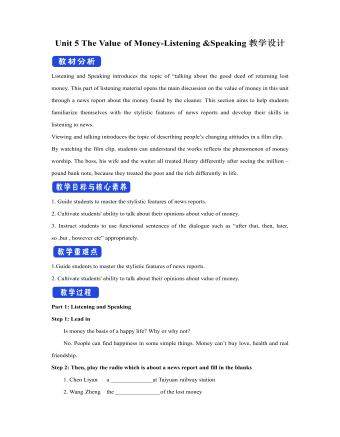
新人教版高中英语必修3Unit 5 The Value of Money-Listening &Speaking教学设计
Step 4: Listen again and decide if the following statements are true (T) or false (F).1 It was the first time Chen Liyan's story was reported. T口 F口2 Chen found 10,000 yuan in a small plastic bag in Taiyuan railway station口 F口3 Wang Zheng apologized to Chen because he couldn't offer her more money. T口 F口4 Chen took out a large loan to cure her daughter, T口 F口5 Wang set up a fundraising website for Chen's daughter after Chen told him about her situation. T口 F口Step 5:After listening, discuss the questions.1 What kind of person do you think Chen Liyan is?Chen Liyan is generous and honest because she returned a large sum of money to the owner.2 Did Chen return the money because she didn't need it?No. She returned the money because it was the right thing to do. Evidence for this is that she refused to accept the reward money because she felt that it had not been earned. 3 Is it common for people to do what Chen did?It depends on the culture. In some countries it is quite common to return money that has been found. In other countries, people believe "Finders are keepers!" 4 How did Wang Zheng feel about the return of his money?He must have been very happy and relieved to have gotten his money back. We know this because he thanked Chen repeatedly and even offered her a reward.5 Why did Ma Dongbao tell Wang about Chen's family?He must have had great sympathy for Chen and her daughter and wanted to help them.'We know this because he arranged help for them. 6 How did the news reporter feel about Chen's actions?The news reporter felt that it showed that money wasn't the most important thing in life. We know this because the reporter told us that this is what Chen believes. and then said, “that's a great attitude to take."
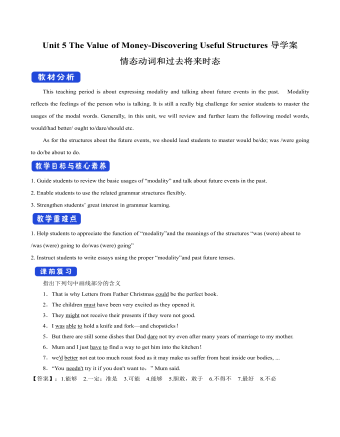
新人教版高中英语必修3Unit 5 The Value of Money-Discovering Useful Structures导学案
4.They were going to find someone to take part in their bet when they saw Henry walking on the street outside.[归纳]1.过去将来时的基本构成和用法过去将来时由“would+动词原形”构成,主要表示从过去某一时间来看将要发生的动作(尤其用于宾语从句中),还可以表示过去的动作习惯或倾向。Jeff knew he would be tired the next day.He promised that he would not open the letter until 2 o'clock.She said that she wouldn't do that again.2.表示过去将来时的其他表达法(1)was/were going to+动词原形:该结构有两个主要用法,一是表示过去的打算,二是表示在过去看来有迹象表明将要发生某事。I thought it was going to rain.(2)was/were to+动词原形:主要表示过去按计划或安排要做的事情。She said she was to get married next month.(3)was/were about to+动词原形:表示在过去看来即将要发生的动作,由于本身已含有“即将”的意味,所以不再与表示具体的将来时间状语连用。I was about to go to bed when the phone rang.(4)was/were+现在分词:表示在过去看来即将发生的动作,通常可用于该结构中的动词是come,go,leave,arrive,begin,start,stop,close,open,die,join,borrow,buy等瞬间动词。Jack said he was leaving tomorrow.
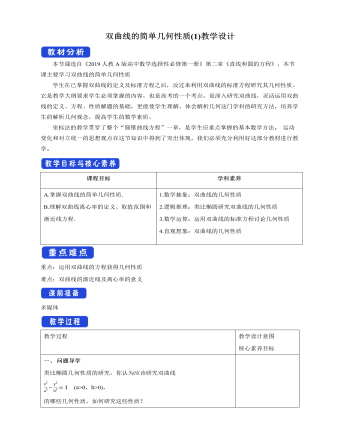
双曲线的简单几何性质(1)教学设计人教A版高中数学选择性必修第一册
问题导学类比椭圆几何性质的研究,你认为应该研究双曲线x^2/a^2 -y^2/b^2 =1 (a>0,b>0),的哪些几何性质,如何研究这些性质1、范围利用双曲线的方程求出它的范围,由方程x^2/a^2 -y^2/b^2 =1可得x^2/a^2 =1+y^2/b^2 ≥1 于是,双曲线上点的坐标( x , y )都适合不等式,x^2/a^2 ≥1,y∈R所以x≥a 或x≤-a; y∈R2、对称性 x^2/a^2 -y^2/b^2 =1 (a>0,b>0),关于x轴、y轴和原点都是对称。x轴、y轴是双曲线的对称轴,原点是对称中心,又叫做双曲线的中心。3、顶点(1)双曲线与对称轴的交点,叫做双曲线的顶点 .顶点是A_1 (-a,0)、A_2 (a,0),只有两个。(2)如图,线段A_1 A_2 叫做双曲线的实轴,它的长为2a,a叫做实半轴长;线段B_1 B_2 叫做双曲线的虚轴,它的长为2b,b叫做双曲线的虚半轴长。(3)实轴与虚轴等长的双曲线叫等轴双曲线4、渐近线(1)双曲线x^2/a^2 -y^2/b^2 =1 (a>0,b>0),的渐近线方程为:y=±b/a x(2)利用渐近线可以较准确的画出双曲线的草图
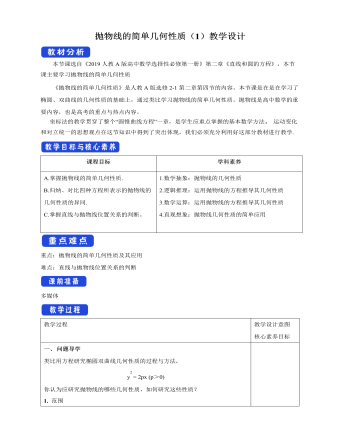
抛物线的简单几何性质(1)教学设计人教A版高中数学选择性必修第一册
问题导学类比用方程研究椭圆双曲线几何性质的过程与方法,y2 = 2px (p>0)你认为应研究抛物线的哪些几何性质,如何研究这些性质?1. 范围抛物线 y2 = 2px (p>0) 在 y 轴的右侧,开口向右,这条抛物线上的任意一点M 的坐标 (x, y) 的横坐标满足不等式 x ≥ 0;当x 的值增大时,|y| 也增大,这说明抛物线向右上方和右下方无限延伸.抛物线是无界曲线.2. 对称性观察图象,不难发现,抛物线 y2 = 2px (p>0)关于 x 轴对称,我们把抛物线的对称轴叫做抛物线的轴.抛物线只有一条对称轴. 3. 顶点抛物线和它轴的交点叫做抛物线的顶点.抛物线的顶点坐标是坐标原点 (0, 0) .4. 离心率抛物线上的点M 到焦点的距离和它到准线的距离的比,叫做抛物线的离心率. 用 e 表示,e = 1.探究如果抛物线的标准方程是〖 y〗^2=-2px(p>0), ②〖 x〗^2=2py(p>0), ③〖 x〗^2=-2py(p>0), ④
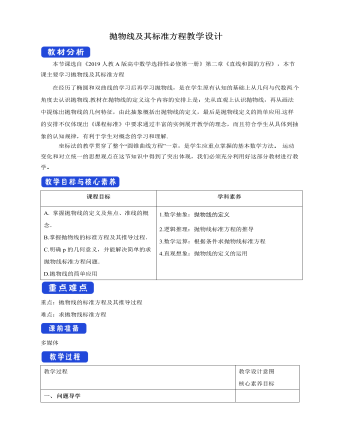
抛物线及其标准方程教学设计人教A版高中数学选择性必修第一册
本节课选自《2019人教A版高中数学选择性必修第一册》第二章《直线和圆的方程》,本节课主要学习抛物线及其标准方程在经历了椭圆和双曲线的学习后再学习抛物线,是在学生原有认知的基础上从几何与代数两 个角度去认识抛物线.教材在抛物线的定义这个内容的安排上是:先从直观上认识抛物线,再从画法中提炼出抛物线的几何特征,由此抽象概括出抛物线的定义,最后是抛物线定义的简单应用.这样的安排不仅体现出《课程标准》中要求通过丰富的实例展开教学的理念,而且符合学生从具体到抽象的认知规律,有利于学生对概念的学习和理解.坐标法的教学贯穿了整个“圆锥曲线方程”一章,是学生应重点掌握的基本数学方法 运动变化和对立统一的思想观点在这节知识中得到了突出体现,我们必须充分利用好这部分教材进行教学
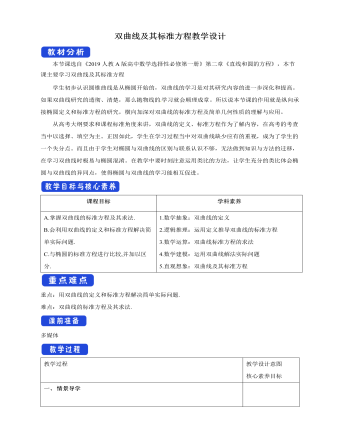
双曲线及其标准方程教学设计人教A版高中数学选择性必修第一册
∵在△EFP中,|EF|=2c,EF上的高为点P的纵坐标,∴S△EFP=4/3c2=12,∴c=3,即P点坐标为(5,4).由两点间的距离公式|PE|=√("(" 5+3")" ^2+4^2 )=4√5,|PF|=√("(" 5"-" 3")" ^2+4^2 )=2√5,∴a=√5.又b2=c2-a2=4,故所求双曲线的方程为x^2/5-y^2/4=1.5.求适合下列条件的双曲线的标准方程.(1)两个焦点的坐标分别是(-5,0),(5,0),双曲线上的点与两焦点的距离之差的绝对值等于8;(2)以椭圆x^2/8+y^2/5=1长轴的端点为焦点,且经过点(3,√10);(3)a=b,经过点(3,-1).解:(1)由双曲线的定义知,2a=8,所以a=4,又知焦点在x轴上,且c=5,所以b2=c2-a2=25-16=9,所以双曲线的标准方程为x^2/16-y^2/9=1.(2)由题意得,双曲线的焦点在x轴上,且c=2√2.设双曲线的标准方程为x^2/a^2 -y^2/b^2 =1(a>0,b>0),则有a2+b2=c2=8,9/a^2 -10/b^2 =1,解得a2=3,b2=5.故所求双曲线的标准方程为x^2/3-y^2/5=1.(3)当焦点在x轴上时,可设双曲线方程为x2-y2=a2,将点(3,-1)代入,得32-(-1)2=a2,所以a2=b2=8.因此,所求的双曲线的标准方程为x^2/8-y^2/8=1.当焦点在y轴上时,可设双曲线方程为y2-x2=a2,将点(3,-1)代入,得(-1)2-32=a2,a2=-8,不可能,所以焦点不可能在y轴上.综上,所求双曲线的标准方程为x^2/8-y^2/8=1.
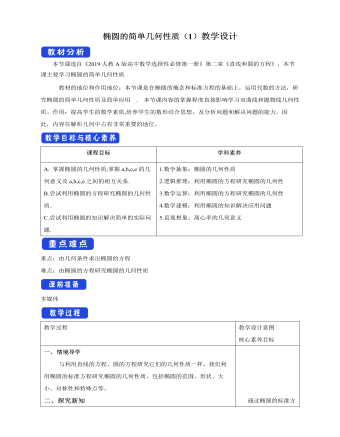
椭圆的简单几何性质(1)教学设计人教A版高中数学选择性必修第一册
1.判断 (1)椭圆x^2/a^2 +y^2/b^2 =1(a>b>0)的长轴长是a. ( )(2)若椭圆的对称轴为坐标轴,长轴长与短轴长分别为10,8,则椭圆的方程为x^2/25+y^2/16=1. ( )(3)设F为椭圆x^2/a^2 +y^2/b^2 =1(a>b>0)的一个焦点,M为其上任一点,则|MF|的最大值为a+c(c为椭圆的半焦距). ( )答案:(1)× (2)× (3)√ 2.已知椭圆C:x^2/a^2 +y^2/4=1的一个焦点为(2,0),则C的离心率为( )A.1/3 B.1/2 C.√2/2 D.(2√2)/3解析:∵a2=4+22=8,∴a=2√2.∴e=c/a=2/(2√2)=√2/2.故选C.答案:C 三、典例解析例1已知椭圆C1:x^2/100+y^2/64=1,设椭圆C2与椭圆C1的长轴长、短轴长分别相等,且椭圆C2的焦点在y轴上.(1)求椭圆C1的半长轴长、半短轴长、焦点坐标及离心率;(2)写出椭圆C2的方程,并研究其性质.解:(1)由椭圆C1:x^2/100+y^2/64=1,可得其半长轴长为10,半短轴长为8,焦点坐标为(6,0),(-6,0),离心率e=3/5.(2)椭圆C2:y^2/100+x^2/64=1.性质如下:①范围:-8≤x≤8且-10≤y≤10;②对称性:关于x轴、y轴、原点对称;③顶点:长轴端点(0,10),(0,-10),短轴端点(-8,0),(8,0);④焦点:(0,6),(0,-6);⑤离心率:e=3/5.
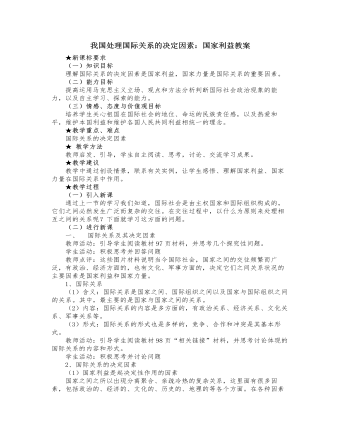
人教版高中政治必修2我国处理国际关系的决定因素:国家利益教案
从国际法角度看,国际社会的每一个主权国家应该是一律平等的,但是,在现实的国际关系中,每个国家的国际地位、国际影响力,历来都是由国家力量决定的。国家力量发生变化,也会引起国际关系的变化。经济、科技落后,军力不强,国内政局不安,它的国际影响力、参与力就不强。正因为如此,某些发达国家往往以其强大的国家力量为后盾,推行霸权主义、强权政治。二、维护我国的国家利益教师活动:阅读教材第100页内容,思考讨论为什么要维护我国的国家利益?我国的国家利益包括哪些内容?学生活动:认真思考并积极讨论,踊跃发言1、原因我国是人民当家作主的社会主义国家,国家利益与人民的根本利益相一致。维护我国的国家利益就是维护广大人民的根本利益,具有正当性和正义性。2、内容我国国家利益的主要内容包括:安全利益,如国家的统一、独立、主权和领土完整;政治利益,如我国政治、经济、文化等制度的巩固;经济利益,如我国资源利用的效益、经济活动的利益和国家物质基础的增强等。
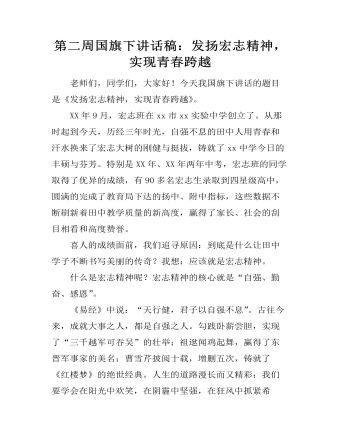
第二周国旗下讲话稿:发扬宏志精神,实现青春跨越
老师们,同学们,大家好!今天我国旗下讲话的题目是《发扬宏志精神,实现青春跨越》。XX年9月,宏志班在xx市xx实验中学创立了。从那时起到今天,历经三年时光,自强不息的田中人用青春和汗水换来了宏志大树的刚健与挺拔,铸就了xx中学今日的丰硕与芬芳。特别是XX年、XX年两年中考,宏志班的同学取得了优异的成绩,有90多名宏志生录取到四星级高中,圆满的完成了教育局下达的扬中、附中指标,这些数据不断刷新着田中教学质量的新高度,赢得了家长、社会的刮目相看和高度赞誉。喜人的成绩面前,我们追寻原因:到底是什么让田中学子不断书写美丽的传奇?我想:应该就是宏志精神。什么是宏志精神呢?宏志精神的核心就是“自强、勤奋、感恩”。《易经》中说:“天行健,君子以自强不息”。古往今来,成就大事之人,都是自强之人。勾践卧薪尝胆,实现了“三千越军可吞吴”的壮举;祖逖闻鸡起舞,赢得了东晋军事家的美名;曹雪芹披阅十载,增删五次,铸就了《红楼梦》的绝世经典。人生的道路漫长而又精彩:我们要学会在阳光中欢笑,在阴霾中坚强,在狂风中抓紧希望,在暴雨中坚守理想;自强不息,乐观向上,走出一条属于自己的人生之路。
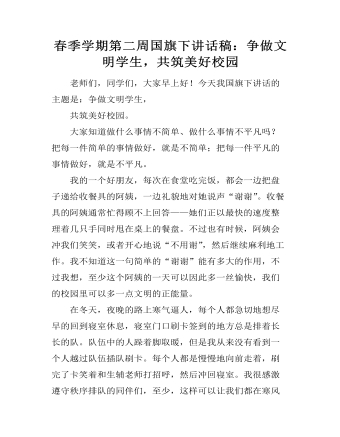
春季学期第二周国旗下讲话稿:争做文明学生,共筑美好校园
老师们,同学们,大家早上好!今天我国旗下讲话的主题是:争做文明学生,共筑美好校园。大家知道做什么事情不简单、做什么事情不平凡吗?把每一件简单的事情做好,就是不简单;把每一件平凡的事情做好,就是不平凡。我的一个好朋友,每次在食堂吃完饭,都会一边把盘子递给收餐具的阿姨,一边礼貌地对她说声“谢谢”。收餐具的阿姨通常忙得顾不上回答——她们正以最快的速度整理着几只手同时甩在桌上的餐盘。不过也有时候,阿姨会冲我们笑笑,或者开心地说“不用谢”,然后继续麻利地工作。我不知道这一句简单的“谢谢”能有多大的作用,不过我想,至少这个阿姨的一天可以因此多一丝愉快,我们的校园里可以多一点文明的正能量。